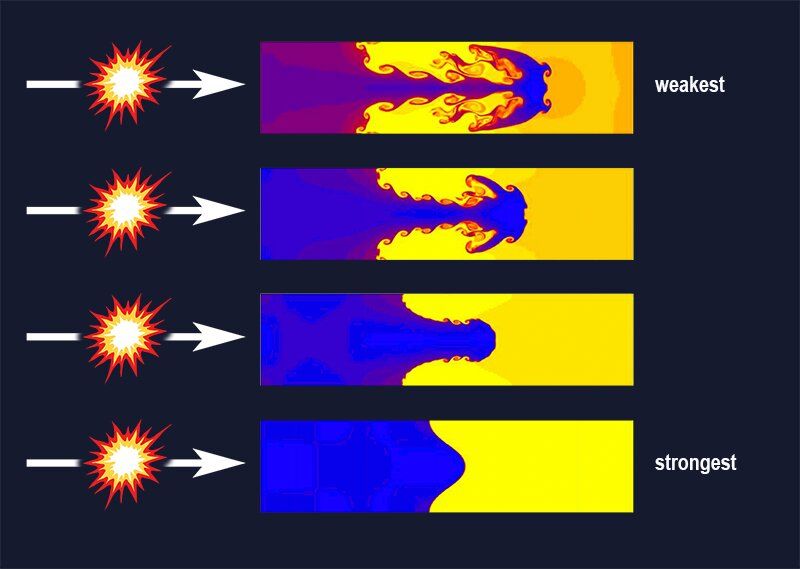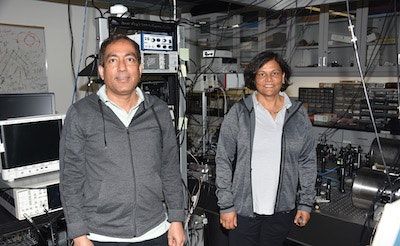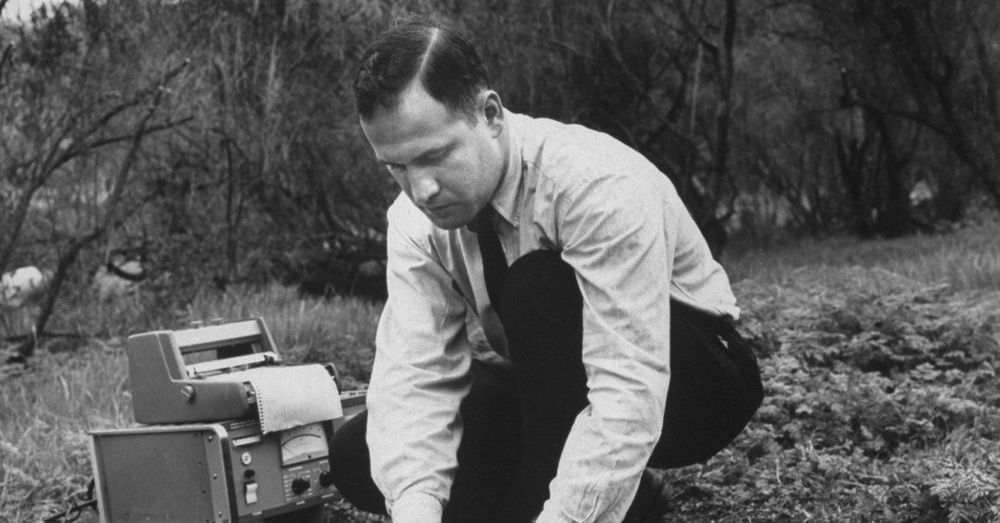Archive for the ‘military’ category: Page 197
Nov 14, 2019
Rapidly compressing lead to planetary-core type pressures found to make it stronger than steel
Posted by Quinn Sena in categories: materials, military
A combined team of researchers from Lawrence Livermore National Laboratory in the U.S. and Atomic Weapons Establishment in the U.K. has found that rapidly compressing lead to planetary-core type pressures makes it stronger than steel. In their paper published in the journal Physical Review Letters, the group describes how they managed to compress the metal so strongly without melting it.
Defining strength in a material is difficult. Strength can refer to a material’s ability withstand bending or breaking under certain conditions. Making things even more complicated is that the strength of any given material can change under varying conditions—such as when heat or compression are applied. In this new effort, the researchers showed just how difficult it can be to nail down how strong a material is—in this case, lead.
Lead is not very strong. Pressing a fingernail against a car’s battery terminal is enough to create indentations, for example. But the researchers with this new effort report that the metal can be strengthened considerably by exerting extreme pressure.
Nov 12, 2019
Who shrank the drug factory? Briefcase-sized labs could transform medicine
Posted by Derick Lee in categories: biotech/medical, economics, military
Historically, the pharmaceutical industry has relied on economies of scale, mixing hundreds of litres of reagents in massive reaction chambers to make millions of doses of a single drug. Bio-MOD and related systems, however, cycle small amounts of chemicals through a series of thumb-sized chambers that can produce hundreds or thousands of doses of multiple drugs, all in less than 24 hours. Several teams have won support for this vision from the US military: the Defense Advanced Research Projects Agency (DARPA) has handed out more than US$15 million to support these do-it-yourself drug-makers.
Engineers are miniaturizing pharmaceutical production in the hope of making it portable and inexpensive.
Nov 12, 2019
Radioactive ‘Tomb’ in Pacific Filled With Nuclear Waste Is Starting to Crack
Posted by Quinn Sena in categories: materials, military
In the Marshall Islands, locals have a nickname for the Runit Dome nuclear-waste site: They call it ‘The Tomb’.
The sealed pit contains more than 3.1 million cubic feet (87,800 cubic meters) of radioactive waste, which workers buried there as part of efforts to clean hazardous debris left behind after the US military detonated nuclear bombs on the land.
From 1977 to 1980, around 4,000 US servicemen were tasked with cleaning up the former nuclear testing site of Enewetak Atoll. They scooped up the contaminated soil, along with other radioactive waste materials such as military equipment, concrete, and scrap metal.
Nov 11, 2019
The U.S. military, algorithmic warfare, and big tech
Posted by Quinn Sena in categories: information science, military, robotics/AI
The U.S. military is preparing for the age of AI and algorithmic warfare, and it’s getting help from tech giants like Facebook, Google, and Microsoft.
Nov 8, 2019
DSU gets nearly $240,000 research grant from Army
Posted by Saúl Morales Rodriguéz in categories: biotech/medical, military, quantum physics
The Department of Defense has awarded Dr. Gour Pati, professor of Physics and Engineering at Delaware State University a $239,908 grant from the U.S. Army to develop and build a millimeter-wave quantum sensing system at DSU.
Dr. Pati – the principal investigator – and his researchers have recognized the increasing importance of millimeter-wave sensing and imaging in commercial and military sectors, as well as how it is driving the development of low-cost sensors. Dr. Pati’s success in winning the DoD grant engages DSU scientists and students in the work of furthering this advancement.
Rydberg atoms have a hypersensitive response to microwave, millimeter-wave and terahertz radiation. They have the potential for applications in modern communications, remote sensing and many other fields, including medical science. Pati and his team will develop a real-time millimeter-wave sensor using laser-induced fluorescence in Rydberg atoms.
Nov 5, 2019
What if We Nuke a City?
Posted by Pat Maechler in categories: augmented reality, existential risks, military

Learn more about nuclear weapons and what you can do to stop them.
EN: http://www.notonukes.org
FR: http://www.sansarmesnucleaires.org
ES: http://www.nomasarmasnucleares.org
PT: http://www.fimdasarmasnucleares.org
DE: http://www.neinzuatomwaffen.org
AR: http://www.notonukes.org/ar
RU: http://www.notonukes.org/ru
CH: http://www.notonukes.org/zh
Spread the word and use the following Hashtags:
EN: #nuclearban FR: #nuclearban
ES: #nomasarmasnucleares
PT: #fimdasarmasnucleares
Nov 1, 2019
Sheldon Breiner, 82, Dies; Used Magnetism for Explorations
Posted by Genevieve Klien in categories: government, military
Ever since the compass was invented, perhaps about 2,000 years ago, humans have used Earth’s magnetic field to guide them. Many ages later, Sheldon Breiner devised ways to use magnetism to guide him to things that might otherwise never have been found — like sunken ships, a lost city and colossal basalt heads buried underground.
Dr. Breiner, a geophysicist, inventor and serial entrepreneur, started a company called Geometrics in 1969 that built sophisticated magnetometers, which measure magnetic fields. (A compass is probably the most simple example of one.) He then discovered how to use them to detect objects by observing the way the objects affect the magnetic fields that surround them.
Dr. Breiner had started employing rubidium magnetometers to detect seismic activity along the San Andreas Fault when he was studying geophysics at Stanford University. In time he harnessed magnetometers to search for mineral and oil deposits deep underground; find hidden weapons; locate skiers lost in avalanches; and help the government track down sunken submarines and a hydrogen bomb that had fallen into the ocean after a B-52 bomber collided with a refueling jet over Spain in 1966.
Oct 30, 2019
Researchers transmit energy with laser in ‘historic’ power-beaming demonstration
Posted by Klaus Baldauf in categories: energy, military

It was the second day of a three-day-long tech demonstration at the David Taylor Model Basin at the Naval Surface Warfare Center in Bethesda, Maryland, where attendees had gathered to stand around in the dark to look at something they mostly couldn’t see.
It was a long-range, free-space power beaming system — the first of its kind. Attendees that day, May 23, could see the system itself—the two 13-foot-high towers, one a 2-kilowatt laser transmitter, the other a receiver of specially designed photovoltaics. But the important part, the laser that was beaming 400 watts of power across 325 meters, from the transmitter to the receiver, was invisible to the naked eye.
Oct 23, 2019
US Air Force gets its first anti-drone laser weapon from Raytheon
Posted by Klaus Baldauf in categories: drones, military
Raytheon has delivered the first anti-drone buggy to the US Air Force, just over year after it introduced the technology. It’s a high-energy laser system mounted on a small all-terrain vehicle, to be specific, which uses electro-optical/infrared sensors to detect and track drones. After it identifies and tracks the unwelcome flying device, it then neutralizes it with its laser in a process that takes a few seconds.














